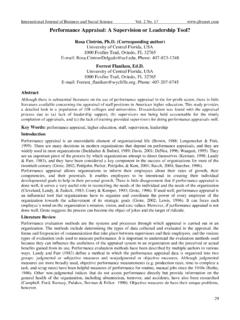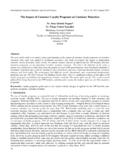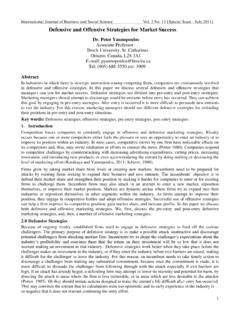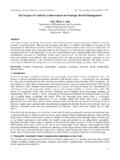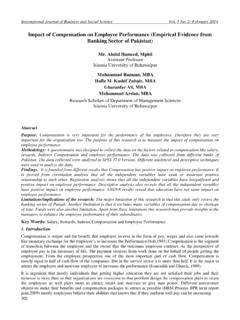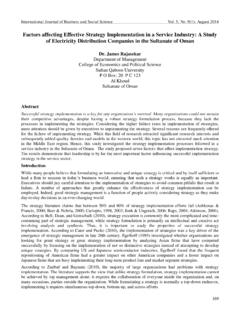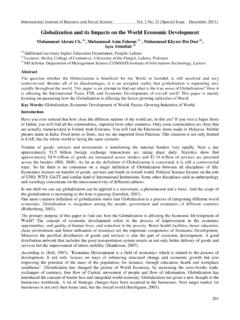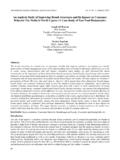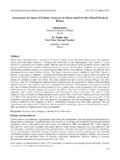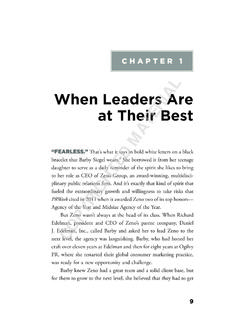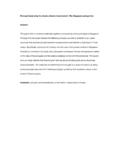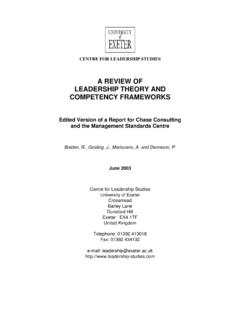Transcription of Developing Leadership in Global and Multi-cultural ...
1 International Journal of Business and Social Science Vol. 2 No. 13 [Special Issue - July 2011] 13 Developing Leadership in Global and Multi-cultural Organizations Dr. James Prewitt Assistant Professor of Business Hawaii Pacific University United States of America E-mail: Dr. Richard Weil Assistant Professor of Business St. Leo University United States of America Anthony McClure, MS Adjunct Professor of Management Western Pennsylvania. United States of America Abstract This paper provides a definition of Leadership , explores Global Leadership , and how managers can develop the Leadership skills necessary in a dynamic, Global environment. The definition and the examination of Global Leadership provide a foundation for Developing leader effectiveness in a Global and diverse organizational environment. The emphasis is on Leadership in formal, Global , and diverse organizations and the Leadership principles that can be practiced, applied, and concluded with some guiding principles from the literature.
2 Key Words: Global Leadership , Multi-cultural organization , management. Introduction The study of Leadership has been an ongoing process for many, many years and has been broadly defined as a process of social influence. Leadership , unlike management, is not dependent on position, title or privilege; instead it is an observable, understandable, and learnable setp of skills that can be mastered by anyone that is willing to take the time and put forth the effort to learn them (Yukl, 1998). It has been suggested by several authors that few terms inspire less agreement than the definition of Leadership . If you believe that Leadership is a dynamic process of interaction among and between people, then a clear definition may not be possible. Bass suggested in 1990 there may be as much definition as there are authors on the subject (Kreitner & Kinicki, 2001).
3 Yukl also remarked on the numerous definitions, the differences are not just a case of scholarly nitpicking. They reflect deep disagreement about identification of leaders and Leadership processes (1998, ). However, any discussion of Leadership demands a definition be put forth as a part of the exercise. Therefore, the following definition is put forth as a part of our discussion: The capability to create a vision and communicate that vision to others to share in making that vision a reality. - Leadership is dynamic - Leadership is not a function of level or position Furthermore, leaders have certain fundamental beliefs and attributes: - Leaders believe that honest and ethical behavior are foundational values of true Leadership . - Leaders use holistic thinking, communication, and accountability as the fundamental attributes of Leadership . Leadership is the ability to influence others by setting and inspiring example.
4 The example is one that motivates people to pursue goals that benefit the organization . Typically, Leadership involves creating a vision of the organizational future, devising a strategy for achieving that vision, and communicating that vision to all members of the organization . The Special Issue on Business and Management Centre for Promoting Ideas, USA 14 When the vision is communicated, the leader must ensure the vision is clear so that everyone within the organization understands it. Global Leadership also entails providing an atmosphere that will encourage and stimulate people to surmount obstacles (Kouzes & Posner, 1995). Debate has been raging in the popular management literature concerning whether leading and managing are different behaviors.
5 They are different behaviors. One of the major differences between leaders and managers is the ability to influence change. Managers maintain the direction and oversee processes. Managers create stability. Leaders create change and set the direction. A leader can take people and an organization in a new direction with their Leadership abilities. Organizational members are looking to the Leadership to communicate, collaborate, and to set the course for the organization . Leaders use their collaboration and communication skills and abilities to gain the trust of people and through their actions, he or she gains influence. It is the ability to influence others that gives a leader his or her power. It is the leader that creates the vision and uses their influence with others to make the vision a reality. Without the leader setting the course and navigating through those bumps and dips that occur, the organization may be headed for a crash.
6 Hard work and talent will only take you and your organization so far. A lack of Leadership stifles any further progress. Literature Review Developing a Global Leadership Model Globalization has seemingly overwhelmed many organizations and leaders within them because of the rapid pace and lack of training many leaders have had on dealing with and understanding the various communities across the globe. Many organizations spend more time and resources providing employees training on new equipment and software than Developing managerial and Leadership skills. This occurs many times in spite of the discussion that visionary Leadership is what is needed to compete, succeed, and to continue to grow as an organization in our Global world. Another reason may be due to the fact that until very recently, Global business was considered the purview of a few large businesses and as a sideline for the few others that participated in this area.
7 Morrison (2000) uses these reasons for Developing a model of Global Leadership and the competencies that are required to successfully implement the Leadership model. Morrison (2000) points out that Global Leadership models must draw from many academic disciplines to be able to understand and appreciate the business environment across the globe. By using a multi -disciplinary approach, leaders are able to understand the communities where the organization is present and have the ability to work with and motivate people in the different cultures. The model also points out that domestic Leadership models that work in a particular country will not always work in the Global environment (Morrison, 2000). Within the United States, the concept of long-term efficiencies are common in Leadership . The exploitation of short-term inefficiencies is not always congruent with the culture and the realities in the Global marketplace, so there must be new ways of looking at Leadership within the context of organizational goals and Global realities.
8 The central point of Morrison s (2000) article is that to develop a workable and realistic model for Global Leadership , the organization must understand how the model should be structured so as to take into account the need for culture, Global strategy, and the development of Leadership competencies that are needed to move the organization forward in a competitive manner. To be able to provide training to provide training for leaders in Global Leadership competencies for the future utilizing a generalized model of Global Leadership , the organization must ensure there are people within the organization that have the knowledge, skills, and abilities to teach and train on this multi -disciplinary approach. Without having these trained people, it may be difficult if not impossible to imbue the organization with the competencies because there will be a serious lack of credibility within the organization for the trainer(s) and the it is important that an organization develop a Global Leadership model that works for them, various organizations must work together to develop a universally applicable Leadership model that is separate from the internal model that works just within that particular organization (Morrison, 2000).
9 By creating this Global Leadership model, all organizations can change the model to meet their needs and assist to integrate their organization into the Global economy while at the same time helping to meet all the organizational goals for a particular company. There also needs to be a specific component that addresses the importance of culture on the Leadership model and the practice of Leadership within the Global environment. By addressing the cultural component of Leadership , leaders will be able to understand and apply difference culturally relevant Leadership behaviors and skills (Morrison, 2000). International Journal of Business and Social Science Vol. 2 No. 13 [Special Issue - July 2011] 15 By addressing the cultural element organizations can determine if they are strong or weak in the areas that deal with local and regional cultures throughout the globe.
10 By understanding these aspects, an organization will be able to have a seamless integration with strategic partners or communities throughout the world without the enormous pressure to accomplish this integration without the knowledge of how to accomplish the goals. Exploring a Taxonomy of Global Leadership Competencies and Meta-competencies Tubbs and Schultz (2006) make the argument that there is nothing more important than to define and describe the competencies that make-up Leadership within Global organization . These competencies need to be defined and described so that organizations can ensure they are taught throughout the organization so as to help achieve the strategic goals that move the organization forward within the industrial self-confidence of the leader is something that is paramount in the area of personality that must be taken into account when it comes to Leadership competencies.
